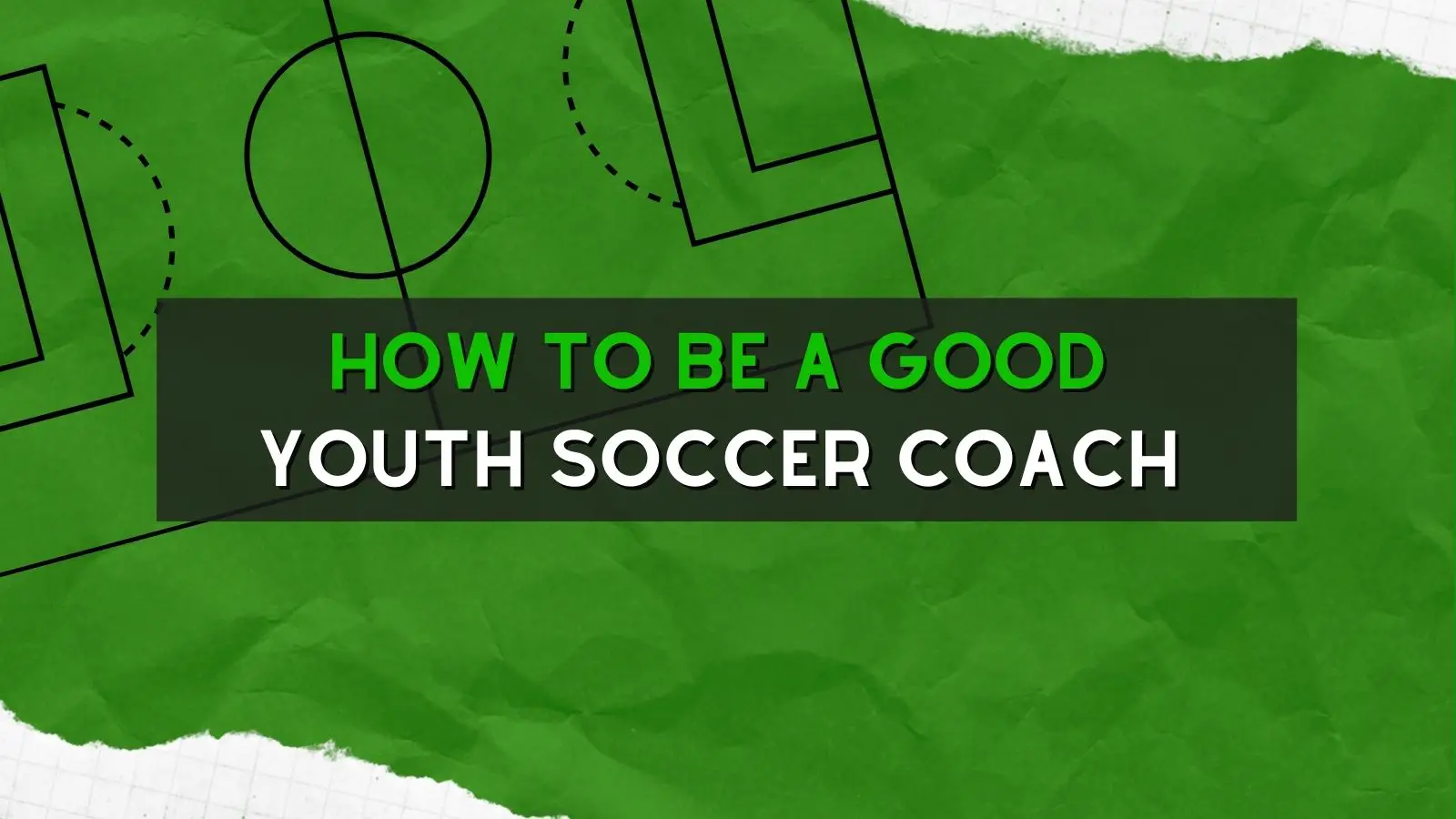How To Be A Good Youth Soccer Coach

As an affiliate, we may earn from qualifying purchases. We get commissions for purchases made through links on this website. You can read more on our Affiliate Disclaimer here.
What makes a good youth soccer coach?
Honestly, I reckon the fact that you are even trying to find out how to be a better soccer coach says a lot! Well done to you! So let’s get into what makes a good youth soccer coach and how to develop your coaching skills to become one.
Your most significant responsibility as a youth soccer coach is to take into consideration the ability of each player under your tutelage and follow that up with the appropriate training plan and program.
Sometimes we forget that youth soccer players are not little adults; therefore, a practice session that would be appropriate for a college team may not be so for u10, u9, u8, and so on.
It is essential to assess each individual players’ skill level. Likewise, to understand if they are coming to the table with absolutely no skill at all and what that entails.
Things such as tactical knowledge, fitness levels, and physical maturity will all come into play when developing an engaging training program, which leaves no team member behind! In each session, all players should be engaged and active, continually learning and growing.
Although we all need to be pushed outside of our comfort zone to truly develop, activities shouldn’t be too physically or technically challenging for them, as they may become disengaged. Yet, they should allow your players to push themselves and rise to the challenge, which will naturally lead them to achieve a higher standard of performance.
That is essentially how to be a good youth soccer coach — planning suitable training sessions that are geared towards the strengths and weaknesses of your team.
Now that we understand how to be a good youth soccer coach and what it entails. Let’s look at some soccer coaching fundamentals and how to apply them.
How To Be A Good Youth Soccer Coach :
11 Coaching Fundamentals

The following outlines apply to players of all ages and ability levels and will aid you with preparing adequate training programs and practice sessions. Keep in mind, these are simply suggestions and, as such, will need to be amended to suit the needs and goals of your team.
1. Create a positive learning atmosphere.
If you want to become a great soccer coach, creating the most positive learning atmosphere is important. Whether you are introducing soccer to a team of youth or tweaking some professionals’ performance, an unstimulating, non-engaging practice will result in a poor learning environment for all.
Of course, it goes without saying that practices should be demanding, organized, and targeted. But practices should also be enjoyable and engaging for everybody involved. Keep players active, involved, and touching the ball; nobody should be sat down doing nothing. Maximize your time during each session.
With thoughtful planning and creativity, you can best meet their needs in producing a stimulating, motivational, educational environment, and practice sessions to match. This way, you will meet your targets with ease.
2. Develop a theme.
Don’t try to incorporate too many points in a single session, especially if your team is relatively young. Instead, plan respectively around a central theme.
For example, the main focus of a training session might be to develop passing and receiving techniques or to create goal-scoring opportunities through creative dribbling. Try to organize the training around a mixture of drills and practice games pertaining to one main theme.
3. Consider your players’ soccer age.
A player’s “soccer age” relates to their level of proficiency. Often times, a player’s soccer age may vary significantly from their actual age.
Beginners who are yet to even touch a soccer ball are developmentally behind players the same age as them who have been playing soccer for years. Therefore, the player who has been playing for longer has more experience and thus, has a higher soccer age.
Beginners may have trouble executing even the most basic skills, so try not to place them in positions where they have little or no chance of achieving some measure of progress.
Your goal is to plan an obtainable goal and then continually adjust it. One that challenges players but is also within their physical and mental capacities.
Taking into account their technical abilities (skill), physical maturity, and developmental stage, and then creating a practice tailored towards those.
4. Use Your Time Wisely

The more a player gets to perform and physically experience an action. Ie. Passing, receiving, shooting, heading, or dribbling the ball, the more likely he or she will enjoy training and benefit from the session overall.
Likewise, standing around listening to soccer theory for ages before actually being given the chance to get some touches is no good for anybody. Ensure you have enough soccer balls so that there is one for each player at the very least.
You can buy soccer balls in batches of 4, 8, 12, etc., on Amazon fairly cheaply, or if you already have or intend to collect balls as you go, there are mesh bags made especially for multiple quantities.
An abundance of soccer balls equips you with a lot more opportunities with regard to activities and practice games. This all adds to making training more engaging and fun for the team as they are continuously on the move, touching the ball, and not stagnant.
If you are not quite in a position to supply all of the soccer balls yet or have not collected enough from your community or charity, another straightforward way to ensure a sufficient number of balls is to require each player to bring a ball to practice. In the same way that baseball players carry their glove to the field, soccer players can bring a ball.
5. Keep the session simple. Soccer is a simple game… Keep it that way!
Complex drills before they are ready and advanced training systems will only frustrate your players and make things more complicated than they need to be. You want to be motivating them; this will do the opposite.
KISS:
When you plan your training sessions, always consider the KISS principle of coaching — keep it simple, stupid! Honestly, you can apply this principle to all sports (and many lessons in life in general)
6. Teach in a progression.
Planning an effective training session entails more thought than merely selecting multiple unrelated activities and randomly using them during a training session.
Every training session should lay the groundwork for the other sessions and games that will follow. Start the practice with basic exercises and build up to more matchlike conditions.
For example, the session might start with simplistic passing games that involve minimal movement and steadily progress to a more fast-paced exercise forcing the players to move at game speed and under the pressure of their opponents.
Where and how they start depends on the skill of the individual. Higher-skilled players will naturally start with more challenging exercises than beginners. However, in both instances, you will need to organize the flow of the practice so that they each serve as a precursor for the next. And again, each session should relate to the original main theme I mentioned before.
7. Keep it player-centered.
Training should always be player-centered, not coach centered.
Once you introduce them to the topic and provide any necessary demonstrations or answer questions they might have, that’s it; it is time to get them active!
Remember, avoiding long periods of inactivity is key as the less time they sit around being passive, the more they play, and the better the session goes. You can always stop the action if need be to advise or give constructive feedback.
8. Ensure a safe training environment.
Most coaches nail having the right soccer equipment needed to train their teams but what about ensuring their safety?
Every contact sport carries its own levels of physical risk; soccer is no different. Accidents happen, collisions, bumps, and bruises will occur from time to time. If you wish to decrease the chances of such injuries, make every effort to provide your team with a safe practice and playing environment.
A safe environment is inclusive of:
- Supervising
- Planning
- Matching players appropriately (size and ability), and,
- Establishing guidelines for appropriate behavior
If you have not already outlined your soccer coaching philosophy, now would be a great time to do so. You could include it in your forms you have your team or their parents’ sign as a sort of code of conduct.
Players should always wear the appropriate gear during practice and games. Field players and goalkeepers alike should wear shin guards (shin pads) to prevent common lower-leg injuries. Most guards are rather reasonably priced and made with light but durable plastic.
Goalkeepers should wear equipment that best suits their role, such as padded shorts or full-length pants. This is especially needed if playing on firm natural or artificial turf. Shorts and long pants both have padded hip areas. Additionally, gloves are vital for goalkeepers, for protecting their hands as (hopefully) they will be catching a lot of rapid, hard, flying soccer balls!
If your team is particularly young, then you could also opt for protective head-gear for your goalkeeper to reduce the chances of head injuries.
Another safety element people do not consider is choosing the right goalpost. It seems like a no-brainer, but you need to take special care when you choose a set of soccer goals. Notwithstanding their heavyweight, a portable full-size goal (8 feet high by 24 feet wide) can very easily fall over if it isn’t correctly secured. Similarly, when there are strong winds, these are known to topple over often and, young plays like to climb or hang on the post! So, portable goals have their purpose, of course, just be sure to consider your training location and circumstances when choosing a goalpost.
In the scenario presented above, the best option would be a strong, professionally made goal, securely anchored to the ground. The only caveat is these are also quite expensive.
Don’t worry, though, as if you are trying to keep your costs low, you can always use cones, flags, or any markers you can find to represent the goal.
Additionally, most youth-size goals can be reliably anchored with sandbags (they usually come with some sort of suitable anchor in any case)
9. Practice economically viable training.

It is common for coaches only to have a session or two a week. This makes it challenging to include everything you want to in the time you have. To use your practice time effectively, always try to include components of fitness, techniques, and tactics into every activity.
Also, be sure to include a ball in each exercise, even the ones which are there solely to improve fitness levels.
Whatever the length of the session may be, just ensure that the time is well spent and that the quality of the training makes up for the quantity.
10. End with a game
More than anything, soccer players want to play the game!
Ending each practice session with a game will be a nice reward to the training and give them a chance to put into play what they have learnt, they will certainly look forward to it.
You do not need to conduct a full-blown 11 v 11 match. But instead, smaller 3v3 – 6v6 games will be more suitable in this case as playing with fewer players per team enables players a better chance to touch the ball. They will be engaging in a lot more passing, receiving, dribbling, and shooting in smaller groups.
Small-sided matches also give your team the chance to make more judgment calls because they are immediately involved in practically every play, a situation that elevates tactical advancement. The emphasis on positional play also significantly decreases because each player must defend and attack, encouraging overall player development.
Finally, the number of opportunities they have to score is also increased significantly in smaller group games, making the session even more enjoyable for all.
Remember, making mistakes and learning from them are crucial roles in the learning process; therefore, players should be urged to take risks and experiment so they can learn what works and what doesn’t. And again, you can always take a brief moment to stop play and correct mistakes if need be.
11. Conduct A Session Evaluation
When you conclude each training session, it’s good practice to reflect on how things went throughout that particular session. Ask yourself these questions:
- Were they enjoying the session?
- Was the practice too long—did they remain engaged or lose interest half-way?
- Was it too short— did they feel disappointed or unsatisfied at it concluding?
- Did each player get enough touches on the ball?
- Were all players given a chance to perform both attacking and defending skills?
- Did all players have multiple opportunities to go to the goal?
Try to come up with more questions along these lines, as answering these after each session will allow you to adjust your coaching method accordingly and help to craft a great learning environment for your team.
If you are a soccer coach and want to improve your coaching sessions, the best way to do this is to get feedback from your team in a simple and non-intrusive way. You can download our free training session feedback form here.


